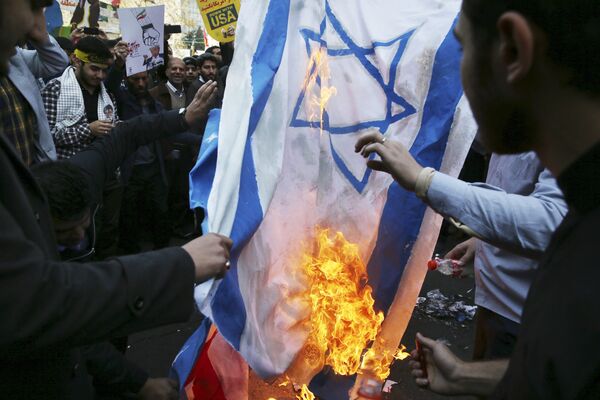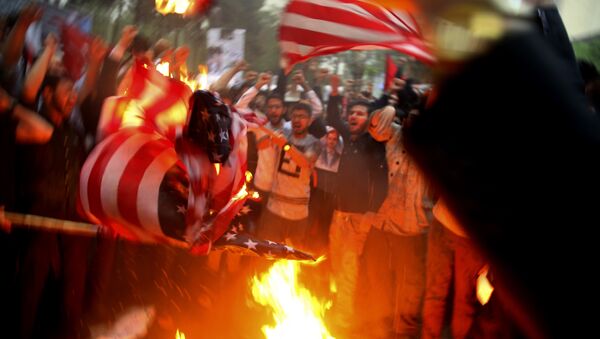Diba Parcham, an Iranian flag factory located in a town of Khomein, 325 kilometres south-west of Tehran, is boosting its business by manufacturing US, British and Israeli flags which remain hot selling items among Iranians.
The reason for the surprising popularity of the "enemy" banners is that they are traditionally burnt during mass protests and demonstrations in the Islamic Republic.
Ghasem Ghanjani, the owner of the factory, explains that the factory produces up to 3,000 flags per month: "For three years our company has been producing different types of flags: national religious, company and foreign ones".
According to Ghanjani, there are certain peak seasons for selling American and Israeli ensigns, in particular on the eve of the celebration of the Islamic Revolution Day, which will be celebrated on celebrated on 11 February this year; Al-Quds Day, an annual event held on the last Friday of Ramadan in support of Palestinian Arabs; the anniversary of the seizure of "Den of Spies" – the name given to US Embassy in Tehran – in November 1979 when a group of Iranian university students and their supporters stormed the compound and held its staff hostage for 444 days.

The owner of the factory specifies that usually the main buyers of the flags are government agencies, including the mayor's office, ministries, state funds, as well as hotels. Ghanjani elaborates that the prices of flags vary and usually depend on their purpose. The company is producing "vertical flags" for display on buildings, bridges and other structures. The second group is comprised of "tablecloth" flags, used for various conferences and gatherings.
"There is also a third group of flags that we produce for demonstrations and processions", the Iranian businessman explains. "Each group of flags has its own sizes, so it’s hard to name any particular price. But I can say that the prices of state flags fluctuate between 10,000 and 15,000 tomans (about 1 dollar)".
However, on national events "enemy" banners go like hot cakes, according to Ghanjani, who hopes that the situation in the world will change one day.
"I hope that the day will come when people will live in peace, friendship and harmony with each other", the factory owner says. "I hope that the US and Britain will not judge the Iranian people too harshly for burning their national flags, and will try to walk in their shoes instead".
The Islamic Republic of Iran has been known for its tough stance towards the US and Israel since the Islamic Revolution of 1979 when Muslim revolutionaries toppled the US-backed Shah Mohammed Reza Pahlavi and formed a new government under the leadership of Ayatollah Khomeini.
The US-Iranian relations hit a new low following Washington's unilateral withdrawal from the 2015 Joint Comprehensive Plan of Action (JCPOA) commonly known as the Iran nuclear deal. While the Iranian leadership refuses to enter into negotiations with the US until it returns to the JCPOA, Washington continues to beef up its military presence in the region.
On January 3, the US assassinated Iran's Quds Force Commander Qasem Soleimani in a targeted drone strike in Iraq, prompting a nation-wide backlash from the people of Iran who burnt American and Israeli flags and chanting "death to the US". Retaliating for Soleimani's death Tehran launched a missile strike against Iraqi bases housing US troops on 7 January which was followed by the accidental downing of a Ukrainian passenger plane by the Islamic Revolutionary Guards Corps (IRGC) which killed all 176 people on board.




